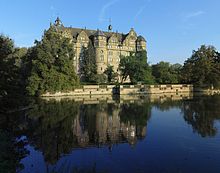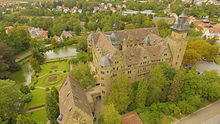Neuenstein Castle
The new stone castle stands in the middle of the city Neuenstein . As the seat of the noble line of Hohenlohe-Neuenstein built, it now houses a museum and castle to the Hohenlohe-Central Archives Neuenstein the care of the State of Baden-Wuerttemberg common Hausarchiv of the Hohenlohe family . In the 41 meter long and over ten meter wide knight's hall , concerts are also regularly held as part of the Hohenlohe cultural summer.
description
architecture
The castle in the style of the Renaissance is a powerful, closed four-wing building with six storeys. At its northwest corner is the Romanesque keep of the former castle . Two further corners are taken up by high round towers. A bridge leads to the entrance portal , which is decorated with the coats of arms of Ludwig Casimir von Hohenlohe and his wife Anna von Solms-Laubach .
The castle museum
As part of a visit to the castle museum, the imperial hall , the royal vault and the late medieval and fully functional castle kitchen - all largely in its original state - can be viewed .
In addition to art-historically valuable objects, hunting weapons and trophies are on display. The heart of the museum, however, is the art and rarities cabinet. It shows works of art from the Renaissance as well as curios and memorabilia; including a hat from the Swedish King Gustav II Adolf , a shoe from Tsarina Catherine the Great and a bladder stone almost the size of a fist belonging to the Count of Nimburg .
history
The roots of today's castle can be found in a Hohenstaufen moated castle from the early 13th century. She stood on a sandbank in a swamp area near an old long-distance trade route that led from the Rhine via Wimpfen east to the Danube .
Around 1230 the complex was owned by the Lords of Stein, whose descendants later called themselves "von Neuenstein", and around 1300 it came to the Counts of Hohenlohe, who used the castle as their residence. The Eschelbacher Steige played an important role as a transport route for the construction and supply of the castle or palace .
After the complex had already been expanded in the 15th century, Count Ludwig Casimir von Hohenlohe had it remodeled in the 16th century by the Heilbronn master builder Balthasar Wolff into a Renaissance style palace. The expansion lasted until the beginning of the 17th century.
After Wolfgang Julius von Hohenlohe died in 1698, the family moved their residence to Öhringen . Neuenstein Castle subsequently stood empty and visibly fell into disrepair. Later it served as a breeding and work house, as a retirement home and orphanage.
From 1870 renovation work was carried out in the Kaisersaal in order to subsequently lay the foundation for a Hohenlohe family museum with a collection of antiques from Kirchberg Castle . It was one of the first private museums in Germany and was open to the public from 1878.
At the beginning of the 20th century, Prince Christian Kraft zu Hohenlohe commissioned the architect and castle researcher Bodo Ebhardt with a comprehensive restoration of the palace. The work took place from 1906 to 1925. In the course of this, the facility was increased by one floor. After the expropriation of the Silesian residence Sławięcice Castle in 1945 and the sales of the Kirchberg and Ingelfingen castles in 1952 and Öhringen in 1961 (and the Friedrichsruhe hunting lodge in 2005), Neuenstein Castle is now both a museum and residence of the owner, Kraft Fürst zu Hohenlohe-Oehringen (* 1933) .
literature
- Constantin Prinz zu Hohenlohe : Neuenstein Castle and its museum (= DKV art guide. No. 155). Edited by Gerhard Taddey , 5th edition. Deutscher Kunstverlag , Munich a. a. 2001.
- Gerhard Taddey: Bodo Ebhardt and the restoration of Neuenstein Castle. In: Harald Siebenmorgen (Hrsg.): Hofkunst in Hohenlohe (= research from Württembergisch-Franken. Vol. 44). Thorbecke, Sigmaringen 1996, ISBN 3-7995-7645-2 , pp. 173-208.
Web links
Individual evidence
- ↑ Neuenstein Castle. Precious art and a 137 gram bladder stone. In: Stuttgarter Zeitung. Edition of May 10, 2007 ( Memento of August 14, 2007 in the web archive archive.today )
Coordinates: 49 ° 12 ′ 14.5 " N , 9 ° 34 ′ 43.5" E




